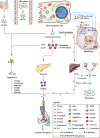Gut microbiota is a potential goalkeeper of dyslipidemia
- PMID: 36176475
- PMCID: PMC9513062
- DOI: 10.3389/fendo.2022.950826
Gut microbiota is a potential goalkeeper of dyslipidemia
Abstract
Dyslipidemia, as a common metabolic disease, could cause atherosclerosis, coronary heart disease, stroke and other cardio-cerebrovascular diseases. It is mainly caused by the interaction of genetic and environmental factors and its incidence has increased for several years. A large number of studies have shown that gut microbiota disorder is related to the development of dyslipidemia closely. Especially its metabolites such as short-chain fatty acids, bile acids and trimethylamine N-oxide affect dyslipidemia by regulating cholesterol balance. In this paper, we systematically reviewed the literature and used knowledge graphs to analyze the research trends and characteristics of dyslipidemia mediated by gut microbiota, revealing that the interaction between diet and gut microbiota leads to dyslipidemia as one of the main factors. In addition, starting from the destruction of the dynamic balance between gut microbiota and host caused by dyslipidemia, we systematically summarize the molecular mechanism of gut microbiota regulating dyslipidemia and provide a theoretical basis for the treatment of dyslipidemia by targeting the gut microbiota.
Keywords: bile acids; dyslipidemia; gut microbiota; short chain fatty acid; trimethylamine N-oxide.
Copyright © 2022 Lei, Zhao, Zhang, Chen, Liu and Piao.
Conflict of interest statement
The authors declare that the research was conducted in the absence of any commercial or financial relationships that could be construed as a potential conflict of interest.
Figures



Similar articles
-
The Gut Microbial Bile Acid Modulation and Its Relevance to Digestive Health and Diseases.Gastroenterology. 2023 Jun;164(7):1069-1085. doi: 10.1053/j.gastro.2023.02.022. Epub 2023 Feb 24. Gastroenterology. 2023. PMID: 36841488 Free PMC article. Review.
-
Effects of Dietary Fibers on Short-Chain Fatty Acids and Gut Microbiota Composition in Healthy Adults: A Systematic Review.Nutrients. 2022 Jun 21;14(13):2559. doi: 10.3390/nu14132559. Nutrients. 2022. PMID: 35807739 Free PMC article.
-
Radiation-induced injury and the gut microbiota: insights from a microbial perspective.Therap Adv Gastroenterol. 2025 Jun 16;18:17562848251347347. doi: 10.1177/17562848251347347. eCollection 2025. Therap Adv Gastroenterol. 2025. PMID: 40535532 Free PMC article. Review.
-
The gut microbiota and its role in the development of cardiovascular disease.Expert Rev Cardiovasc Ther. 2025 Jan-Feb;23(1-2):23-34. doi: 10.1080/14779072.2025.2463366. Epub 2025 Feb 10. Expert Rev Cardiovasc Ther. 2025. PMID: 39915986
-
Digestive dynamics: Unveiling interplay between the gut microbiota and the liver in macronutrient metabolism and hepatic metabolic health.Physiol Rep. 2024 Jun;12(12):e16114. doi: 10.14814/phy2.16114. Physiol Rep. 2024. PMID: 38886098 Free PMC article. Review.
Cited by
-
Association between gut microbiota and diabetic nephropathy: a two-sample mendelian randomization study.BMC Endocr Disord. 2024 Oct 11;24(1):214. doi: 10.1186/s12902-024-01746-7. BMC Endocr Disord. 2024. PMID: 39390505 Free PMC article.
-
Emerging Biomarkers and Determinants of Lipoprotein Profiles to Predict CVD Risk: Implications for Precision Nutrition.Nutrients. 2024 Dec 27;17(1):42. doi: 10.3390/nu17010042. Nutrients. 2024. PMID: 39796476 Free PMC article. Review.
-
Therapeutic Strategies to Modulate Gut Microbial Health: Approaches for Chronic Metabolic Disorder Management.Metabolites. 2025 Feb 13;15(2):127. doi: 10.3390/metabo15020127. Metabolites. 2025. PMID: 39997751 Free PMC article. Review.
-
Hepatic Steatosis Can Be Partly Generated by the Gut Microbiota-Mitochondria Axis via 2-Oleoyl Glycerol and Reversed by a Combination of Soy Protein, Chia Oil, Curcumin and Nopal.Nutrients. 2024 Aug 6;16(16):2594. doi: 10.3390/nu16162594. Nutrients. 2024. PMID: 39203731 Free PMC article.
-
Mechanism of Nephrolithiasis: Does the Microbiome Play a Role?Eur Urol Focus. 2024 Dec;10(6):902-905. doi: 10.1016/j.euf.2024.11.010. Epub 2024 Dec 10. Eur Urol Focus. 2024. PMID: 39665895 Review.
References
Publication types
MeSH terms
Substances
LinkOut - more resources
Full Text Sources

